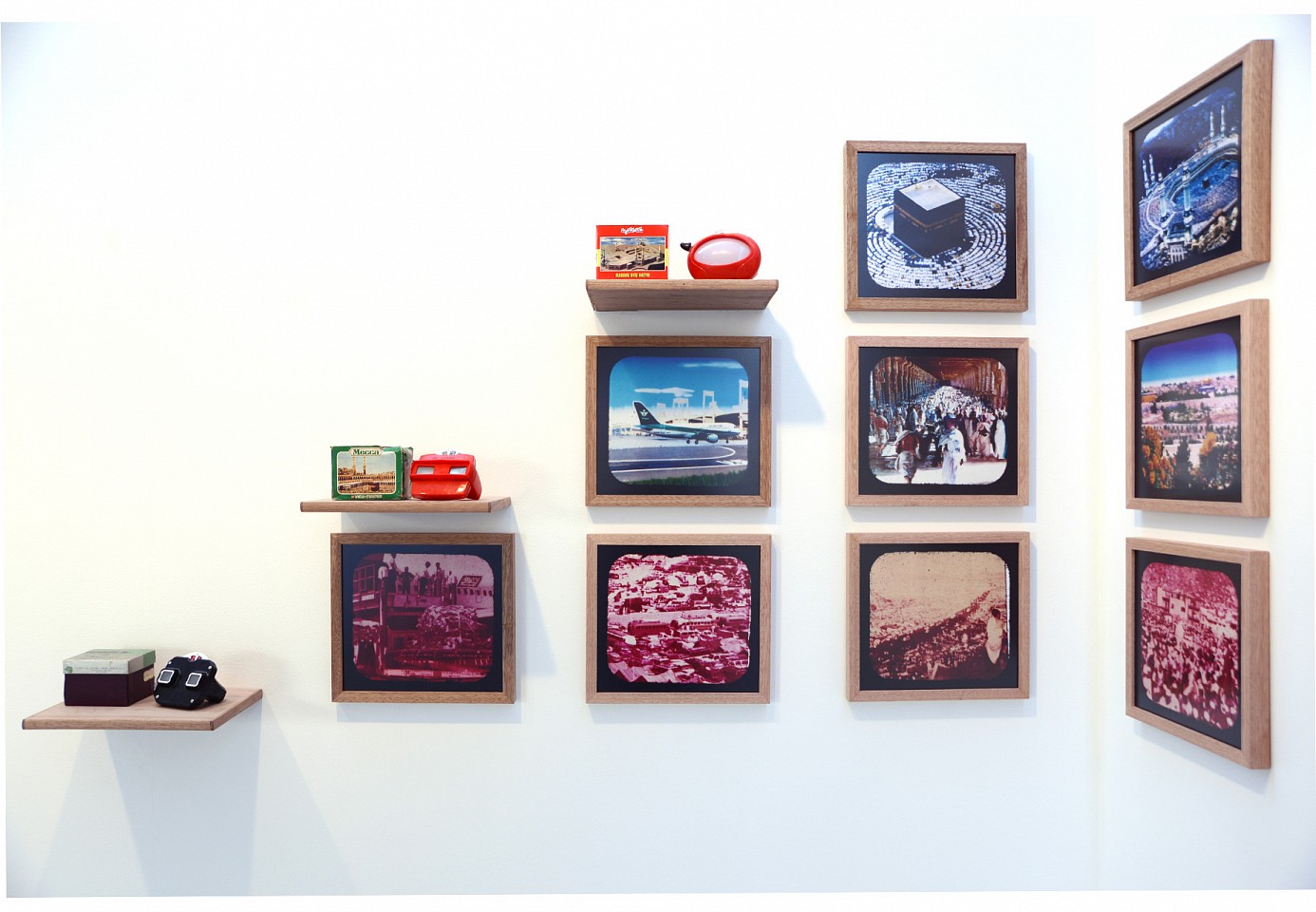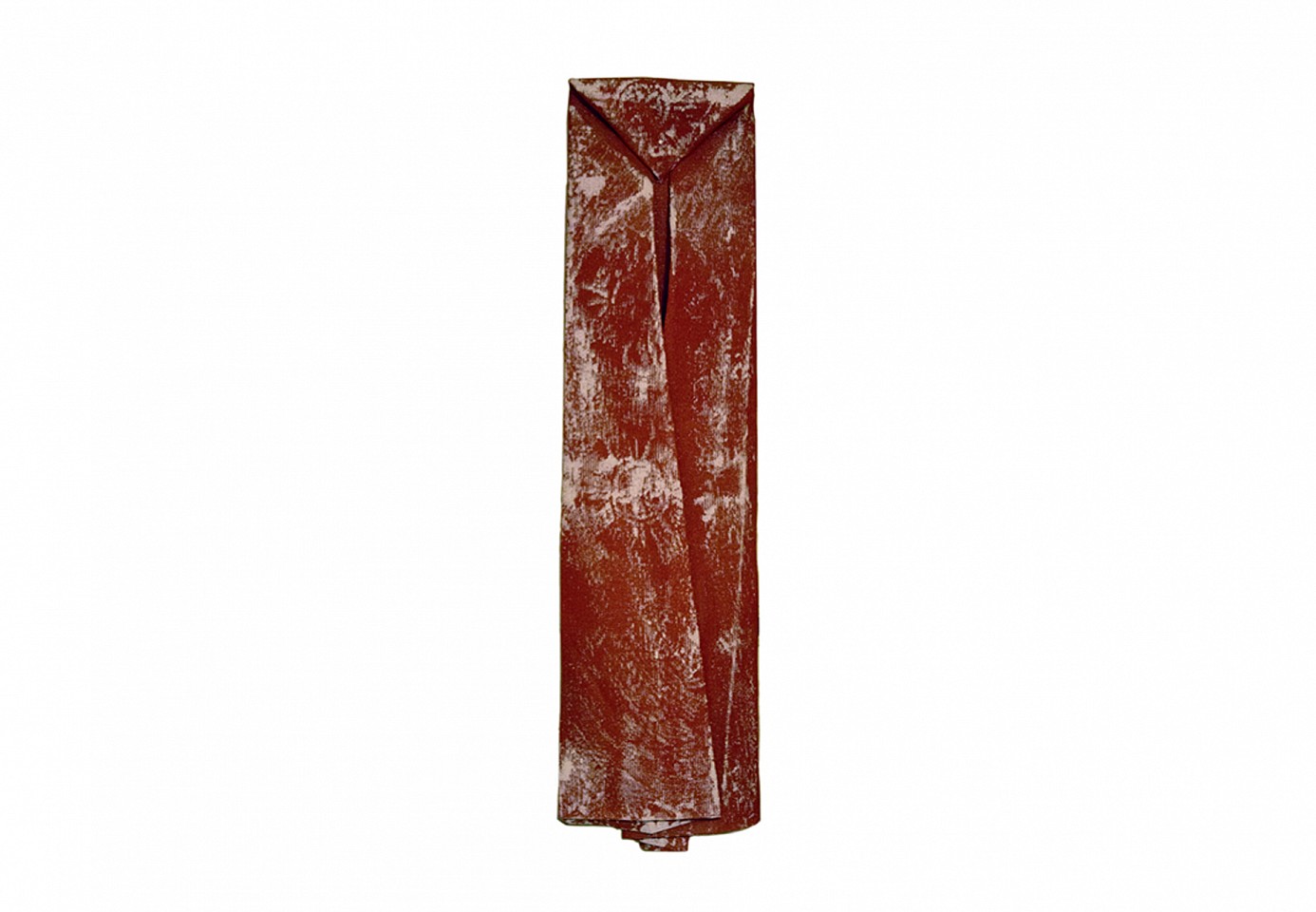Ahmed Mater
View Masters and Slides Installation, 2014
3 various View Masters
24 C- prints, 40 x 40 cm each
Edition of 10 Image courtesy of Sharjah Art Foundation
AHM0204
Ayman Yossri Daydban
Abeed Al Manazil [The House Negro], 2011
Fujicolor Crystal Archive Print
26 x 51 cm each; 8 pieces
From the Subtitle series Edition of 3 + 1 AP
AYD0315
Ayman Yossri Daydban
Red Flag, 2014
Industrial car paint on hessian onion bag
128 x 145 cm (50 3/8 x 57 1/16 in.)
AYD0506
Nasser Al Salem
[It is] The Work of Allah , Who Perfected All Things, 2014
Hand drawn with Rotring ink on cotton paper
21 x 29.7 cm (8 1/4 x 11 11/16 in.)
NAS0226

![Ayman Yossri Daydban, Abeed Al Manazil [The House Negro]
2011, Fujicolor Crystal Archive Print](/images/26986_h125w125gt.5.jpg)

![Nasser Al Salem, [It is] The Work of Allah , Who Perfected All Things
2014, Hand drawn with Rotring ink on cotton paper](/images/27082_h125w125gt.5.jpg)
View Master slides 1960-80 / 1980-2000 and 2000-2020
Images taken from Makkah’s most widely circulated pilgrim keepsake. Made in China since the pre-1960s they have been shipped over in their thousands along the same silk route that has been central to cultural interaction from East to West since 206 BCE. These same View Finders, once bought on Al Khalil Road in Makkah, are then disseminated through the hands of the pilgrims to every corner of the world. The View Finders and their images, are not only visual portals to a city that bristles under the weight of its own dramatic symbolism but a reflection of a site revered by millions created with the specific task of triggering fantasies of a pilgrimage to Makkah and all it implies. As objects, the View Finders embody these dreams, whilst the collection of images, once released from the limitations of their intended form, are transformed. They become not only social documentation but pertinent and poignant signifiers of specific times and places, drawing on collective history, iconography and memory, of a site that is at once the most visited yet the most exclusive in the world.
The basic function of Arabic subtitles in a foreign film is translation. The subtitle works within the context of the film as a narration to the story as well as an explanation of the action that accompanies it. As such, the impact of the picture precedes that of the subtitle and creates the framework for it.
When removed from the context of the film, and re-exported with the image of the film still, the function of the subtitle is transformed from confirming meaning to actually producing it. It is re-born as a unique source of content, with no past or alternative function.
Borders, flags and other symbols of belonging and identity continuously infuse Ayman Yossri’s oeuvre. For the last 10 years, the artist has been constructing and deconstructing the Palestinian flag, reflecting on a shifting understanding of identity and exile, in a process of constant redefinitions.
Ayman belongs nowhere. His Palestinian identity is fragmented and has lost its form and meaning. His flags are, at times, devoid of colours, reflective metal sheets shaped by the sheer force of his body, showing, in the various phases of unfolding, the effort of the human being to break free from the narrow stereotypes which are imposed on him. At other instances, these flags are pieces of paper and recycled objects, hessian bags painted red, all reflecting on a flag ‘empty’ of ideals, representing the politics of national identity in a globalized world.
Nasser Al Salem’s training as an architect has taught him that all objects and creation has a premeditated system in place. This system maps out how components are fused together, how they function, and how then they effect its aesthetical composition.
His work as a calligrapher is also ruled by a system of geometric principles that allow this art an aesthetical, geometrical and spiritual composition, the latter as an extension of himself.
His work fuses a blueprint of calligraphy depicting a verse from the Holy Quran, [It is] The Work of Allah , Who Perfected All Things, [Chapter Al Naml, Verse 88] -- with the notion that all creation has a perfected blueprint in place; mapped out by the creator Himself. He imagines the insight gained, and the state a person would be in, should he observe the blueprint of all creation.
PARTICIPATING ARTISTS
Ahmad Mater
Ayman Yossri Daydban
Aya Haider
Hazem Harb
Nasser Al Salem
Location / Grand Palais , Avenue Winston Churchill , 75008 Paris, France


![<p><span class="viewer-caption-artist">Ayman Yossri Daydban</span></p>
<p><span class="viewer-caption-title"><i>Abeed Al Manazil [The House Negro]</i></span>, <span class="viewer-caption-year">2011</span></p>
<p><span class="viewer-caption-media">Fujicolor Crystal Archive Print</span></p>
<p><span class="viewer-caption-dimensions">26 x 51 cm each; 8 pieces</span></p>
<p><span class="viewer-caption-description">From the Subtitle series
Edition of 3 + 1 AP</span></p>
<p><span class="viewer-caption-inventory">AYD0315</span></p>
<p><span class="viewer-caption-aux"></span></p>](/images/26986_h960w1600gt.5.jpg)

![<p><span class="viewer-caption-artist">Nasser Al Salem</span></p>
<p><span class="viewer-caption-title"><i>[It is] The Work of Allah , Who Perfected All Things</i></span>, <span class="viewer-caption-year">2014</span></p>
<p><span class="viewer-caption-media">Hand drawn with Rotring ink on cotton paper</span></p>
<p><span class="viewer-caption-dimensions">21 x 29.7 cm (8 1/4 x 11 11/16 in.)</span></p>
<p><span class="viewer-caption-inventory">NAS0226</span></p>
<p><span class="viewer-caption-aux"></span></p>](/images/27082_h960w1600gt.5.jpg)


